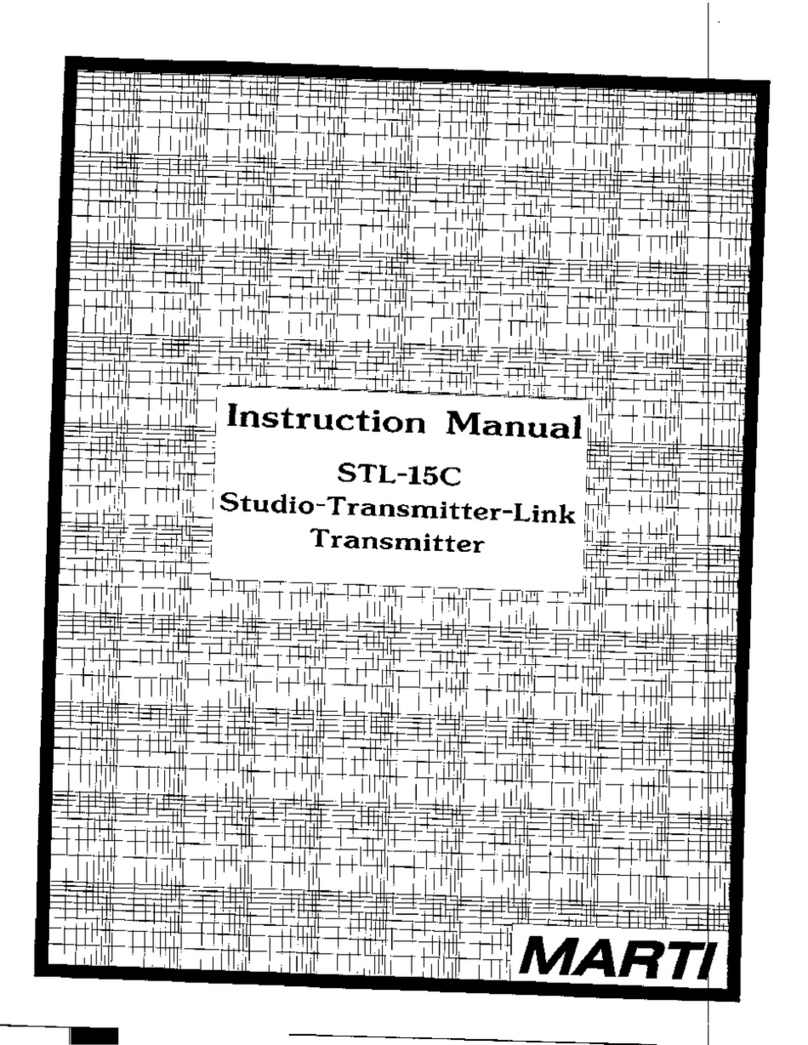
www.SteamPoweredRadio.Com
RPT-25
REMOTE
PICK
UP
TRANSMITTER
S.P-EC
IF
IC-AT
IONS
Application----------------------
Broadcast
Remote
Pick
Up.
Frequency---------
---------------
-450.001 -
455
.95
MHz
.
Crystal
Multiplication-----------
36.
MARTI
ELECTRONICS
Cleburne,
Texas
FrequeRcy
Sta~ility-------~-----
Portable/Mobile:+
,0005%
-30°C
to
+50°C.
1;'wo
(2)
minutes
are
r;quired
~fter
application
of
stand-by
power
for
the
transmit
ter
to
be
in
toleranc€
when
operated
~ortable-mobile
at
temperature.5
below
-10°C
.
Base
Station:+
.00025%
-30°C
to
+50°C two
(2)
minutes
a.fter
initial
application
of
-st-and~hy
power.
Dual
Frequ~mcy
Oper
•
ation---------
Selectable
dual
freE!uency
operation
available
at
eKtra
cost.
Spurious
Emission--
--------------
Spurious
radiation
attenuated
more
than
60
DB
below
carrfer
ley.el.
RF
Output------------------------
Maximum
25
watts,
nominal
20
watts
into
50 ohms.
VSWR
Protection------------------
High
VSWR
will
not
damage
transmitter.
RF
Connector---------------------
UG-58A/U.
Temperature
Range----------------
-20°C
to
+45°C.
Modulation----
----
-------------
--
Model
---
Deviation
Emission
RPT-25P
1.5
KHz,.
10F3
RPT-25N2 5
KHz.
25F3
RPT-25R 9 -KHz.
50F3
RPT-25S
22,5
KHz.
100F3
Audio
Inputs------
,---
----
--
--·----
Four
-
inputs
are
provided
with
individual
mixing
·
gain
coatrels
.
three
of
the
inputs
are
for
micro-
phones
(one
push-to-talk)
and
one
input
accepts
balanced
600
ohm
line.
Audio
Input
Leve
l---
--
-- -
-----
---
Microphon
e
input
level
can
be
from
-70
DB
to
-45
DB,
Line
input
level
can
be
from
-20
DBM
to
+4
DBM
.
Audio
Input
Impedance------------
-Will
accept
microphones
from
150
to
600
ohms.
Line
input
600 ohms
balanced,
Audio
Connectors-·---------------
Inp
ut
No. 1 (XLR--4-31).
Input
Nos.
2,
3,
and
4
(XLR-3-3
1).
Power
Requirements-------·--------
115/230
volts
AC,
50/60
Hz.,
155
watts
transmitt-
ing,
30
watts
standby.
13.6
volts
DC
negative
ground.
7
amp
.
transmitting,
0,5
amp.
standby.
Modulation
Control---------------
Marti
CA-40
Compressor/Limiter
Module.
Selector
switch
for
measuring
audio
level,
compressor
gain
reduction,
RF
output,
etc,
Weight---------------------------
20
lbs.
net,
26
lbs.
gross
.
Dimensions-----------------------
6-k"
high
by 15
11
wide
by 12
11
deep.
NOTES:
(1)
Measured
through
4
KHz
. low
pass
audio
filter.
(2)
Pre-selector
recommend
ed
when
receiver
is
located
near
UHF
transmitter.
(3)
The
extremely
good
sel
ectivit
y
of
this
receiver
results
in
some
reduc-
tion
of
audio
response
and
increased
distortion
,
Ever
increasiqg
use
of
UHF
frequencies
dem
ands
this
selectivity
in
modern-receivers.






























